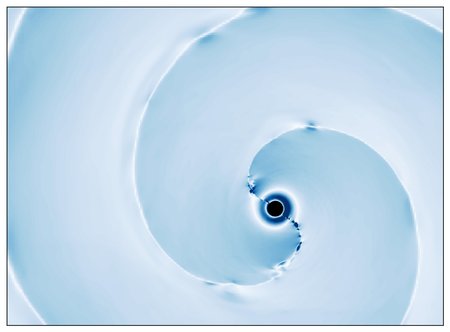The full moon of March, called the Worm Moon, will occur on Sunday (March 28), at 2:48 p.m. EDT (1817 GMT).
Two days later, the moon will reach perigee, the nearest point to Earth in its orbit. This means the moon will appear slightly larger than usual in the night sky and may be referred to as a “supermoon” (by some definitions), according to NASA. The near-full moon will also share the sky with a planetary conjunction, but only for Southern Hemisphere skywatchers.
The full moon will be in the constellation Virgo, and have an angular diameter (apparent size) of 33 arc minutes, slightly larger than the average of 31 arc minutes across. An arc minute is one-sixtieth of a degree, so the difference in size to most people won’t be noticeable. (For reference, your clenched fist held at arm’s length measures about 10 degrees wide.)
Related: Full moon names (and more) for 2021
A supermoon?

The reason the full moon will appear larger than usual is that on Tuesday (March 30) at 2:13 a.m. EDT (0613 GMT), the moon will be at perigee, or its closest to the Earth for this orbit, according to NASA. The moon’s orbit isn’t a perfect circle, and at perigee it will be 360,309 kilometers form the Earth, versus an average 384,400 kilometers (240,000 miles).
When the full moon coincides with perigee it is sometimes called a “supermoon” — but in this case the full moon will miss perigee by about 35 hours. “Supermoon” isn’t an official technical term used by astronomers, and the term is somewhat arbitrary. Whether a full moon counts as “super” depends on how close to the full moon the user of the word thinks perigee should be.
“Supermoons have become popular over the last few decades. Depending upon how you interpret this definition, in a typical year there can be 2 to 4 full supermoons in a row,” NASA said in a statement.
Observing the moon
Full moons happen when the moon is exactly on the opposite side of the Earth from the sun. We see the moon illuminated by the sun’s light, unless the moon’s orbit carries it within the shadow of the Earth, resulting in a lunar eclipse. This full moon will “miss” the Earth’s shadow, because the moon’s orbit is inclined five degrees with respect to the plane of the Earth’s orbit. That inclination is why we don’t have a lunar eclipse every month. If an astronaut were standing on the moon, from their perspective the sun would be directly overhead — it would be lunar noontime.
Through binoculars or a small telescope the full moon appears so bright it can be hard to spot surface details, because there are no shadows. Moon filters are available that can make some features stand out, but waiting a few days after the full moon or observing a few days before, shadows bring out more detail.
Visible planets, stars and constellations

Being in the constellation Virgo, the moon will make a rough triangle with Arcturus, the brightest star in the constellation Boötes, the herdsman, and Denebola, the second-brightest star in Leo, the lion. Arcturus will be to the north of the moon — at about 9:30 p.m. local time in mid-northern latitudes Arcturus will be to the right of the moon, and Denebola above it with the moon in the east-southeast. In New York City moonrise is at 7:19 p.m. the evening of March 28 and moonset is the next morning at 7:29 a.m. The sun sets the evening of March 28 at 7:16 p.m.
On March 30 Mercury and Neptune will make a close pass to each other, with Mercury passing within a degree and a half of Neptune. Only Mercury is visible with the naked eye; Neptune requires at least a small telescope. The two should fit in the same view of a pair of binoculars, according to the skywatching website In-The-Sky.org.
But the conjunction won’t be visible to observers in the Northern Hemisphere, as Mercury will be far too low in the sky. Those in cities like Buenos Aires or Melbourne however, will be able to see Mercury in the dawn hours.
From Buenos Aires Neptune and Mercury rise at 5:38 a.m. and 5:39 a.m. local time, respectively, per Heavens-Above.com. The pair will reach an altitude of about 17 degrees by the time the sun rises at 7:04 a.m. local time, but Mercury, though bright at magnitude 0.4, will probably fade from view before then. Civil twilight starts at about 6:39 a.m. local time in Buenos Aires, when the sun is 6 degrees below the horizon but the sky is light enough that all but the very brightest objects fade from view.
Other visible planets include Mars, which from mid-northern latitudes will be visible after sunset high in the south-southeast. By about 8 p.m. local time on March 28 it will be about 50 degrees above the horizon, in the constellation Taurus, the bull. Mars will be above the star Aldebaran, and to the right of the constellation Orion, the hunter, and sets by about 12:52 a.m. local time in New York City.
From the Southern Hemisphere, Taurus and Orion will appear “upside down” and Mars will be lower in the sky. The sun sets slightly earlier on March 28 than in northern latitudes, as it will be the austral autumn — 6:53 p.m. local time — so the sky will be darker by 8 p.m., but Mars will only be 20 degrees above the horizon, to the right of Aldebaran.
Jupiter and Saturn, meanwhile, will be visible just before dawn. Even though the “Great Conjunction” of the two gas giants occurred in December, the planets are still relatively close together in the sky; both move slowly through the constellations of the zodiac.
Jupiter, for example, will spend about a year in each constellation, as it takes 11.8 years to go around the sun. Saturn takes 29.4 years. From New York City Saturn rises first, at 4:27 a.m. local time, followed by Jupiter at 5 a.m. on the morning of March 29, as the full moon approaches the horizon in the west. Both are in the constellation Capricornus, the sea goat.

In the Southern Hemisphere, the plane of the Earth’s orbit, known as the ecliptic, will meet the horizon at a much steeper angle than in the Northern Hemisphere in the predawn, late-March sky (this is a function of the season; the situation is reversed in September). Saturn and Jupiter will rise much earlier; Saturn at 2:28 a.m. on the morning of March 29 and Jupiter at 3:25 a.m. local time in New York. As a consequence, both will be a lot higher in the sky by dawn.
The March full moon shares the sky with bright winter constellations, which are notable for the fact that they start to set before midnight, making way for the constellations associated with summer. By about midnight on March 28 Orion and Canis Major will be mostly below the western horizon. Vega and Deneb, meanwhile, two of the Summer Triangle stars, will be rising in the east.
The southern half of the sky in mid-northern latitudes is dominated by Leo, which is framed by Boötes to the east (the left as one faces south) and Gemini to the west (the right). From a dark-sky location observers can trace the Hydra constellation, which makes a line of faintish stars that runs roughly diagonally up from east to west.
In mid-southern latitudes Leo is in the northern half of the sky. By 9 p.m. as the full moon gets higher in the northeast, one can see Centaurus in the southeast, which contains Alpha Centauri, our nearest stellar neighbor. Above Centaurus is the Southern Cross, and near the zenith will be Puppis, Carina and Vela, the three constellations that make up the Ship.
How the “Worm Moon” got its name
According to the Ontario Native Literacy Project, the Ojibwe (or Anishinaabe) peoples called it Ziissbaakdoke Giizas, the Sugar Moon, as March is when the maple sap begins to run. It was also the Anishinaabe new year.
The Haida of the Pacific Northwest call the March full moon Xitgaás Kungáay, or “Noisy goose moon,” according to the Tlingit Moon and Tide Teaching Resource published by the University of Alaska at Fairbanks.
In the Southern Hemisphere, March is late summer and early autumn, and the Māori of New Zealand described the lunar month in March to April (as measured between the successive new moons, with the full moon halfway between) as Paengha-whāwhā, which means “all straw is now stacked at the borders of the plantations,” according to the Encyclopedia of New Zealand.
In China, the traditional lunar calendar calls the March lunation the second month, Xìngyuè, or Apricot Month, for when the eponymous trees blossom.
For the Jewish people, the full moon marks the beginning of the holiday of Passover, which commemorates being freed from slavery and being led out of Egypt by Moses. Passover officially begins at sunset on March 27, since in the Jewish calendar days are reckoned from sunset.
You can follow Space.com on Twitter @Spacedotcom and on Facebook.


